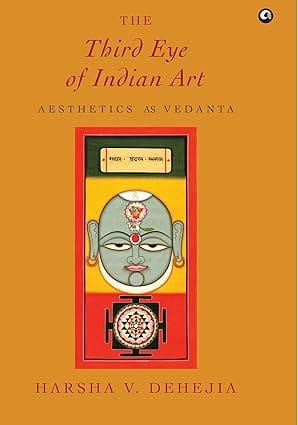WELCOME TO MIDLAND BOOK SHOP!
SHOP FOR
- Contemporary Fiction
- Contemporary Fiction
- Children
- Children
- Comics & Graphic Novels
- Comics & Graphic Novels
- Non-Fiction
- Non-Fiction
- Fiction
- Fiction
Shop No.20, Aurobindo Palace Market, Hauz Khas, Near Church +91 9818282497 | 011 26867121 110016 New Delhi IN
Midland The Book Shop ™
Shop No.20, Aurobindo Palace Market, Hauz Khas, Near Church +91 9818282497 | 011 26867121 New Delhi, IN
+919871604786 https://www.midlandbookshop.com/s/607fe93d7eafcac1f2c73ea4/6468e33c3c35585403eee048/without-tag-line-480x480.png" [email protected]9789365234169 66deec7105812800e2132773 The Third Eye Of Indian Art Aesthetics As Vedanta https://www.midlandbookshop.com/s/607fe93d7eafcac1f2c73ea4/66deec7205812800e213278c/71dfsikbhcl-_sy425_.jpg 9789365234169
Traditional Indian art lends itself to multiple levels of experience, from the creator to the created, from an initial objective sensation to a deeper contemplative subjective experience, from our two outer eyes to an inner or third eye. The Third Eye of Indian Art encourages a rediscovery of India by contemplating its creative vision. While the creation and enjoyment of beautiful objects, vastu, is central to the Indian world view, the discourse on Indian art or aesthetics, saundarya mimamsa, has suffered because we do not have an independent position on aesthetics and have had to borrow from many traditions to create an aesthetic discourse.
This book takes us on an enchanting and blissful aesthetic experience showing us how to use the third eye to not only recognize and celebrate what is objectively beautiful, but to rest in the inner, subjective, serene state of beauty. And as we taste beauty (sundaram) and experience truth (satya) through our third eye, there will be a smaranam—a remembrance of who we really are.
This book takes us on an enchanting and blissful aesthetic experience showing us how to use the third eye to not only recognize and celebrate what is objectively beautiful, but to rest in the inner, subjective, serene state of beauty. And as we taste beauty (sundaram) and experience truth (satya) through our third eye, there will be a smaranam—a remembrance of who we really are.
About the Author
Harsha V. Dehejia has a double doctorate, one in medicine and the other in ancient Indian culture, both from Mumbai University. He is a practising physician and professor of Indic studies, with more than thirty books, four films, and several curated exhibitions to his credit. His main interest is in Indian aesthetics.
He divides his time between India and Canada.
He divides his time between India and Canada.
in stockINR 399
1 1
Email ID already exists!
Your Current password is incorrect
Password Updated Successfully
Thanks for your Feedback
- Home
- Non-Fiction
- The Third Eye Of Indian Art Aesthetics As Vedanta
The Third Eye Of Indian Art Aesthetics As Vedanta
ISBN: 9789365234169
₹399
₹499 (20% OFF)SIZE GUIDE
Sold By: Hauz Khas - Aurobindo Market
Details
- ISBN: 9789365234169
- Author: Harsha V Dehejia
- Publisher: Aleph Book Company
- Pages: 240
- Format: Hardback
Book Description
Traditional Indian art lends itself to multiple levels of experience, from the creator to the created, from an initial objective sensation to a deeper contemplative subjective experience, from our two outer eyes to an inner or third eye. The Third Eye of Indian Art encourages a rediscovery of India by contemplating its creative vision. While the creation and enjoyment of beautiful objects, vastu, is central to the Indian world view, the discourse on Indian art or aesthetics, saundarya mimamsa, has suffered because we do not have an independent position on aesthetics and have had to borrow from many traditions to create an aesthetic discourse.
This book takes us on an enchanting and blissful aesthetic experience showing us how to use the third eye to not only recognize and celebrate what is objectively beautiful, but to rest in the inner, subjective, serene state of beauty. And as we taste beauty (sundaram) and experience truth (satya) through our third eye, there will be a smaranam—a remembrance of who we really are.
This book takes us on an enchanting and blissful aesthetic experience showing us how to use the third eye to not only recognize and celebrate what is objectively beautiful, but to rest in the inner, subjective, serene state of beauty. And as we taste beauty (sundaram) and experience truth (satya) through our third eye, there will be a smaranam—a remembrance of who we really are.
About the Author
Harsha V. Dehejia has a double doctorate, one in medicine and the other in ancient Indian culture, both from Mumbai University. He is a practising physician and professor of Indic studies, with more than thirty books, four films, and several curated exhibitions to his credit. His main interest is in Indian aesthetics.
He divides his time between India and Canada.
He divides his time between India and Canada.
User reviews
NEWSLETTER
Subscribe to get Email Updates!
Thanks for subscribing.
Your response has been recorded.

India's Iconic & Independent Book Store offering a vast selection of books across a variety of genres Since 1978.
"We Believe In The Power of Books" Our mission is to make books accessible to everyone, and to cultivate a culture of reading and learning. We strive to provide a wide range of books, from classic literature, sci-fi and fantasy, to graphic novels, biographies and self-help books, so that everyone can find something to read.
Whether you’re looking for your next great read, a gift for someone special, or just browsing, Midland is here to make your book-buying experience easy and enjoyable.
We are shipping pan India and across the world.
For Bulk Order / Corporate Gifting
 +91 9818282497 |
+91 9818282497 |  [email protected]
[email protected]
Click To Know More
INFORMATION
ACCOUNT
QUICK LINKS
ADDRESS
Midland Book Shop - Hauz Khas
Shop No.20, Aurobindo Palace Market, Near Church, New Delhi
Shop No.20, Aurobindo Palace Market, Near Church, New Delhi














